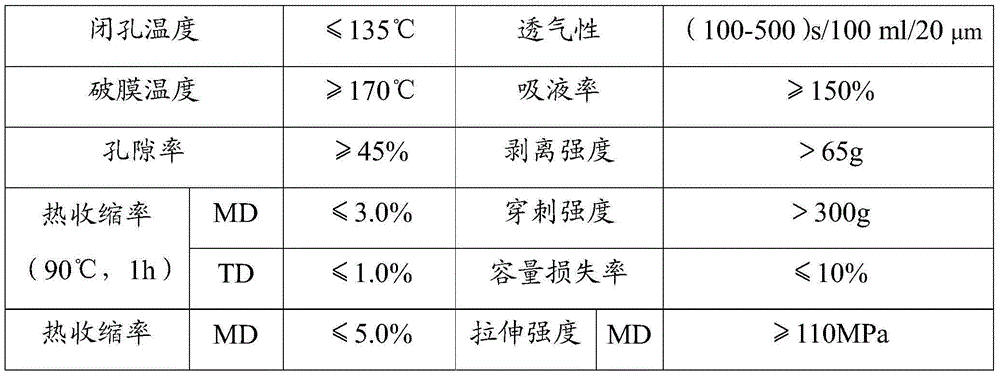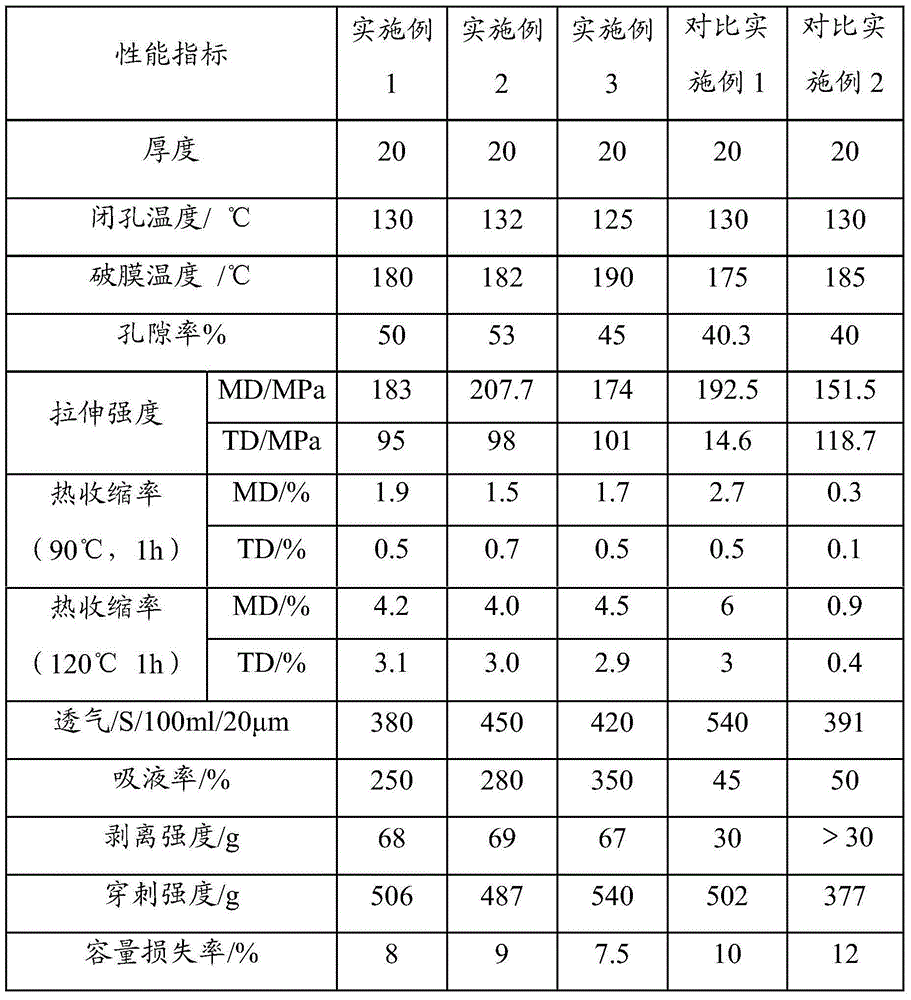A kind of polyolefin multilayer microporous film for lithium ion battery and preparation method thereof
A kind of technology of lithium ion battery and microporous membrane
- Summary
- Abstract
- Description
- Claims
- Application Information
AI Technical Summary
Problems solved by technology
Method used
Image
Examples
Embodiment 1
[0064] Preparation of polyethylene microporous layer: Get 20% high-density polyethylene and 80% liquid paraffin in a twin-screw extruder at 200 ° C by weight, form an oil film on a cooling roll at 25 ° C, and heat the above oil film at 120 ° C Two-way simultaneous stretching is carried out, the stretching ratio is 5×5, and the stretched oil film is subjected to heat setting treatment at 130°C for 20s. The high-boiling-point solvent in the solvent is eluted with dichloromethane extractant, and then dried to obtain a polyethylene microporous layer.
[0065] Preparation of the polypropylene microporous layer: the polypropylene was melt-extruded at 230° C. with an extrusion device, and then cooled to 90° C. for uniaxial stretching to obtain a polypropylene microporous layer.
[0066] Preparation of the ion acceleration layer: Add polyvinylidene fluoride to a mixture of acetone:glycerol=10:1, and prepare an ion acceleration layer solution at a mass ratio of polyvinylidene fluoride:...
Embodiment 2
[0069] Preparation of polyethylene microporous layer: Get 20% high-density polyethylene and 80% liquid paraffin in a twin-screw extruder at 200 ° C by weight, form an oil film on a cooling roll at 25 ° C, and heat the above oil film at 120 ° C Carry out two-way simultaneous stretching with a stretching ratio of 5×5, and heat-setting the stretched oil film at 130°C for 20s. The high-boiling-point solvent in the solvent is eluted with dichloromethane extractant, and then dried to obtain a polyethylene microporous membrane.
[0070] Preparation of the polypropylene microporous layer: the polypropylene was melt-extruded at 230° C. with an extrusion device, and then cooled to 90° C. for uniaxial stretching to obtain a polypropylene microporous layer.
[0071] Preparation of the ion acceleration layer: Add polyvinylidene fluoride and dioctyl phthalate to acetone, and prepare according to the mass ratio of polyvinylidene fluoride: dioctyl phthalate: acetone = 1:0.1:12 into ion accel...
Embodiment 3
[0074]Preparation of polyethylene microporous layer: Get 20% high-density polyethylene and 80% liquid paraffin in a twin-screw extruder at 200 ° C by weight, form an oil film on a cooling roll at 25 ° C, and heat the above oil film at 120 ° C Carry out two-way simultaneous stretching with a stretching ratio of 5×5, and heat-setting the stretched oil film at 130°C for 20s. The high-boiling-point solvent in the solvent is eluted with dichloromethane extractant, and then dried to obtain a polyethylene microporous membrane.
[0075] Preparation of the polypropylene microporous layer: the polypropylene was melt-extruded at 230° C. with an extrusion device, and then cooled to 90° C. for uniaxial stretching to obtain a polypropylene microporous layer.
[0076] Preparation of the ion acceleration layer: Add polyvinylidene fluoride to a mixture of acetone:glycerol=10:1, and prepare an ion acceleration layer solution at a mass ratio of polyvinylidene fluoride:mixture=1:15.
[0077] Pre...
PUM
| Property | Measurement | Unit |
|---|---|---|
| melting point | aaaaa | aaaaa |
| thickness | aaaaa | aaaaa |
| porosity | aaaaa | aaaaa |
Abstract
Description
Claims
Application Information
 Login to View More
Login to View More - R&D
- Intellectual Property
- Life Sciences
- Materials
- Tech Scout
- Unparalleled Data Quality
- Higher Quality Content
- 60% Fewer Hallucinations
Browse by: Latest US Patents, China's latest patents, Technical Efficacy Thesaurus, Application Domain, Technology Topic, Popular Technical Reports.
© 2025 PatSnap. All rights reserved.Legal|Privacy policy|Modern Slavery Act Transparency Statement|Sitemap|About US| Contact US: help@patsnap.com



